Welcome to Boredombusted.com’s fun and informative guide on the rules of pickleball! If you’re looking for a new hobby to bust your boredom, leaning how to play pickleball is a fantastic choice.
In this beginner’s guide, we’ll cover everything you need to know about the exciting sport of pickleball, from its history to the equipment you’ll need, and of course, the rules.
So…
Let’s take a look at…
The what is pickleball, the rules of pickleball, how to play pickleball, variations, types of shots you can play, benefits of the sport – and a number of other great pieces of information to help you get started with this great competitive hobby.
Interesting Related Articles:
Article Content:
So, What is Pickleball?
Pickleball is an exciting and rapidly expanding sport that merges the best aspects of tennis, badminton, and table tennis.
Participants use paddles to volley a lightweight plastic ball across a net on a compact court. This inclusive, beginner friendly game welcomes players of all ages and abilities, encouraging physical fitness, mental acuity, and social camaraderie.
Basic Rules of Pickleball
In this section, we’ll explore the basic rules of pickleball, including court dimensions, scoring, serving, the two-bounce rule, and kitchen rules.
Beginners should find these basic pickleball rules especially helpful!
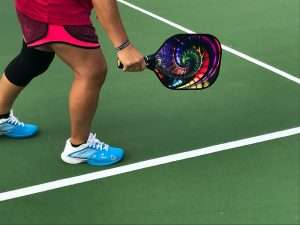
Pickleball Scoring Rules
In pickleball, points are scored by the serving team when the opposing team commits a fault.
A fault can occur when the ball lands out of bounds, the ball doesn’t clear the net, or a player violates the rules.
Games are typically played to 11 points, but they must be won by at least 2 points.
Pickleball Serving Rules
Arguably the most important rules of pickleball revolves around serving the ball!
Let’s take a look at serving rules:
- The server must stand behind the baseline and serve the ball underhand, with the paddle below the waist.
- The serve must be made diagonally, landing in the opponent’s service area.
- The server must hit the ball in the air, without letting it bounce.
- In doubles play, each player on the serving team serves before the serve switches to the opposing team.
- In singles play, the server alternates service courts each time they score a point.
The Two-Bounce Rule
The two-bounce rule states that when the ball is served, both the receiving team and the serving team must let the ball bounce once before hitting it.
This rule encourages longer rallies and makes the game more accessible for beginners.
Kitchen Rules
The kitchen, or non-volley zone, is a 7-foot area on both sides of the net.
One of the most important rules of pickleball is that players are not allowed to volley (hit the ball in the air without letting it bounce) while standing in the kitchen. However, they can step into the kitchen to play a ball that has bounced, as long as they don’t volley it.
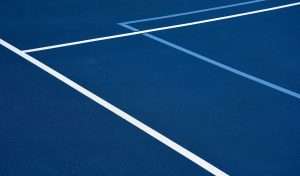
Pickleball Court Dimensions
A standard pickleball court measures 20 feet wide by 44 feet long, which is the same size as a doubles badminton court.
The court is divided into two halves by a net, with each half containing a left and right service area and a 7-foot non-volley zone, also known as the “kitchen.”
Useful external resources:
Pickleball Information for Beginners
Now that you know the basic rules of pickleball, let’s discuss how to get started with this fun and competitive racquet sport.
What Equipment do You Need to Start Playing Pickleball?
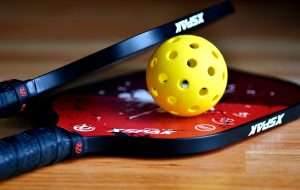
To begin playing pickleball, you’ll need the following equipment:
- Pickleball paddle: Made of lightweight materials like wood, composite, or graphite. Choose one that suits your skill level and budget.
- Pickleball ball: These are lightweight, plastic balls with holes, designed specifically for the sport.
- Net: A standard pickleball net is 36 inches high at the sidelines and 34 inches high at the center.
- Court: As mentioned earlier, a pickleball court is 20 feet wide by 44 feet long.
- You can find dedicated courts in many communities, or you can set up a temporary court on a flat surface like a tennis or badminton court.
Tips for Improving Your Pickleball Skills
As a beginner, you’ll want to practice and improve your pickleball skills.
Here are some tips to help you get started with pickleball:
- Practice your serve: Work on your underhand serve, focusing on placement and consistency.
- Develop your backhand and forehand: Learn the proper techniques for both types of shots, and practice them regularly.
- Work on your footwork: Good footwork is essential for proper positioning on the court, allowing you to hit the ball more effectively.
- Master the dink shot: A dink shot is a soft shot that lands in the opponent’s kitchen, forcing them to hit the ball upward. This can create an opportunity for you to hit a winning shot.
Finding Pickleball Courts Near You
To find pickleball courts near you, try the following resources:
- Check with your local parks and recreation department.
- Use online directories like the USA Pickleball Places 2 Play website.
- Search for pickleball clubs in your area through social media or online forums.
- Visit local community centers or sports facilities.
How to Play Pickleball: Step-by-Step Guide
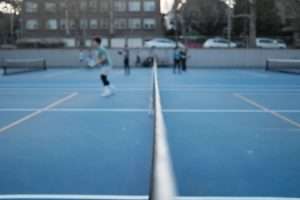
-
Gather your equipment
A pickleball paddle, ball, net, and court will all be needed to play pickleball. Ensure you have all of your equipment before heading out to play.
-
Set up the court
Ensure the court dimensions are correct, and the net is at the proper height.
-
Decide the type of Game
Decide on singles or doubles play and choose your side of the court. Add any variations you see fit to spice up your games!
-
Serve the Ball
Serve the ball underhand, making sure the paddle is below your waist.
-
Follow the two-bounce rule
Allow the ball to bounce once on each side before hitting it.
-
Volley (play!)
Play the ball within the boundaries and avoid hitting it into the kitchen when volleying.
-
Score Points
Score points by causing the opposing team to commit faults.
Remember – only the player who served the round can score points!
-
Decide a Winner
Continue playing until one team reaches 11 points, winning by at least 2 points.
Tools:
- pickleball paddle
- ball
- net
- court
Rules of Pickleball Variations:
Pickleball is a versatile sport that can be enjoyed in various formats and settings.
In this section, we’ll delve into the different variations of pickleball, including singles and doubles play, as well as indoor and outdoor versions of the game.
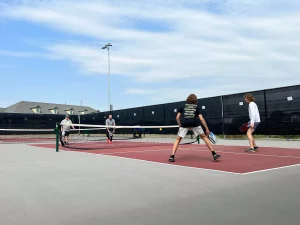
Pickleball Games: Singles vs. Doubles
Singles
In singles pickleball, each player competes individually against their opponent.
Singles play is faster-paced and requires more agility and endurance, as each player is responsible for covering the entire court. Singles games can be more physically demanding but also offer an opportunity to develop individual skills and tactics.
Court dimensions and scoring: The court dimensions and scoring rules remain the same for singles and doubles play.
The only difference is that in singles, players serve and receive serves diagonally across the court, just like in doubles.
Doubles
Doubles pickleball is played with two players on each team, and it is the most popular format of the game. Doubles play emphasizes teamwork, communication, and strategy. Players must coordinate their movements and shots to cover the court effectively and outmaneuver their opponents.
Stacking and switching: In doubles, an advanced strategy called “stacking” can be employed. This involves players standing side by side (instead of the traditional front and back formation) to take advantage of their strong forehand or backhand shots.
Players may switch positions during a point to maintain their preferred formation.
Indoor vs. Outdoor Pickleball
Indoor Pickleball
Indoor pickleball is typically played in gymnasiums, recreation centers, or other indoor facilities with hard surfaces. Indoor play offers a controlled environment, free from weather-related challenges such as wind, sun glare, or rain.
Indoor pickleball balls: Indoor balls are designed with larger holes and are made from softer plastic, which makes them slower and more controllable.
This allows for longer rallies and a slightly different playing style compared to outdoor games.
Outdoor Pickleball
Outdoor pickleball is played on hard courts, similar to tennis courts, and is more common than indoor pickleball. Outdoor play presents additional challenges due to weather conditions, such as wind, temperature variations, and sun glare.
Outdoor pickleball balls: Outdoor balls are made of harder plastic and have smaller holes, making them more durable and able to withstand outdoor court surfaces.
These balls tend to travel faster, and the game is generally played at a quicker pace.
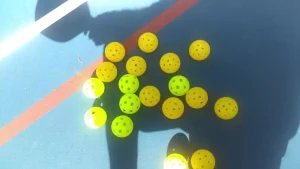
Mixed Doubles
Mixed doubles is a popular format where teams consist of one male and one female player. This variation encourages teamwork and communication between players of different genders and often results in exciting and dynamic gameplay.
Skinny Singles
Skinny singles is a variation of singles play where players only use half of the court, either the left or right side.
This format helps players focus on specific skills, such as ball control and placement, without needing to cover the entire court. It’s an excellent way for beginners to practice or for experienced players to hone their skills.
Round Robin Tournaments
Round robin tournaments are a fun way to enjoy pickleball with a group of players. In this format, players or teams rotate through different opponents in a series of short matches.
The winner is determined based on the total number of games won or points scored. Round robins are popular in social settings and allow players to experience various playing styles and skill levels.
Recreational Pickleball
Recreational pickleball is a casual, informal way to play the game. The focus is on having fun, socializing, and getting exercise, rather than strictly adhering to the rules or engaging in intense competition. In recreational play, players often mix and match partners or modify the rules to accommodate different skill levels and abilities.
Adaptive Pickleball
Adaptive pickleball is a variation designed for individuals with disabilities or limited mobility.
Modifications to the rules, equipment, and court layout can be made to ensure that players of all abilities can enjoy the game. For example, players in wheelchairs might use a smaller court or have different service rules, and those with visual impairments might play with an audible ball.
10 Pickleball Shots to Use – By Difficulty
Now that we’ve covered some of the basic rules of pickleball and how to play, let’s go over the different kinds of shots you can make!

Beginner Shots
1. Dink Shot: A soft shot played just over the net, typically landing in the opponent’s kitchen or no-volley zone. The goal is to force the opponent to hit the ball upward, allowing you to gain an offensive advantage.
2. Groundstroke: A basic shot hit from the baseline or mid-court, usually with topspin or backspin. It’s often used to return serves or as a rally shot.
Intermediate Shots
3. Lob: A high-arching shot aimed to pass over the opponent’s head, forcing them to retreat to the back of the court. This shot requires good timing and control to avoid hitting the ball out of bounds.
4. Volley: A shot hit out of the air before the ball bounces, typically played from the mid-court or close to the net. It requires quick reflexes and good hand-eye coordination.
5. Drive: A powerful, low shot aimed to penetrate the opponent’s defenses. This shot requires good timing and control to generate power while keeping the ball in bounds.
Advanced Shots
6. Drop Shot: A soft, precise shot that lands just over the net, forcing the opponent to move forward quickly. It requires excellent touch and control to execute effectively.
7. Overhead Smash: A powerful, downward shot hit from above the head, usually as a response to a high lob or weak return. This shot requires good timing, footwork, and strength to generate power.
8. Erne Shot: A risky shot where a player stands outside the sideline and hits a volley to surprise the opponents. This shot requires excellent positioning, anticipation, and court awareness.
9. Around-the-Post (ATP) Shot: A shot hit around the net post instead of over the net, typically in response to a wide-angled shot. This shot requires exceptional control, accuracy, and court awareness.
10. Third Shot Drop: A soft shot played after the serve and return, aimed to land in the opponent’s kitchen or no-volley zone. It is intended to neutralize the opponent’s advantage and transition from defense to offense. This shot requires good touch, control, and consistency.
Playing Pickleball on a Tennis Court
If there are no dedicated pickleball courts available, don’t worry! You can easily play pickleball on a tennis court with a few adjustments.
Here’s a beginner-friendly guide to help you get started.

Step 1: Gather Your Equipment
Here’s what you’ll need to play pickleball on a tennis court:
- Pickleball paddles
- Pickleball balls
- Markers (cones, water bottles, or rubber strips)
- Measuring tape (optional)
Tip: Avoid using chalk, paint, or tape to mark the court without permission from the court owner or manager.
Step 2: Mark the Court
To transform a tennis court into a pickleball court, follow these guidelines:
- Baseline: Use the service box lines parallel to the net as your pickleball court’s baseline.
- Centerline: The tennis court’s centerline in the service box will be your pickleball court’s centerline.
- Sidelines: You have two options:
- Mark sidelines 3 ½ feet from each tennis court’s singles lines using markers. Line calls will be approximate; give the benefit of the doubt for the ball being “in.”
- Use the tennis court’s singles lines as your sidelines. This option makes the court wider and requires more side-to-side movement. Choose this option if you don’t have enough markers and can physically cover the additional court.
- Kitchen or No-Volley Zone: Measure and mark 7 feet from the net towards the baseline using markers. Place markers along each sideline where it intersects the kitchen line and one on the centerline, ensuring they don’t interfere with play or create a safety risk.
- Net Height: Tennis nets are 2 inches higher than pickleball nets.
You have two options:
- Lower the tennis net 2 inches in the middle by sliding the center strap an inch or so to one side. Don’t make permanent alterations and restore the strap to its original position after playing.
- Leave the tennis net as is.
This will make playing on a regulation pickleball net seem easier later on.
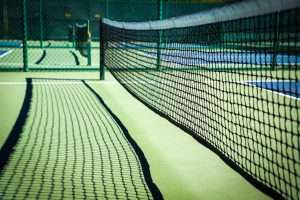
Step 3: Play Pickleball!
Follow the standard rules of pickleball with one exception and one recommendation:
- Exception: If the ball hits any marker on the court, replay the point (a “let”).
- Recommendation: Give the benefit of the doubt on “out” calls and kitchen violation calls. The goal is to enjoy the game and get some exercise.
Pickleball Etiquette & Terminology
In this section, we’ll discuss proper pickleball etiquette and common terms used in the sport.
A. Proper Pickleball Etiquette
- Always show good sportsmanship and be respectful to your opponents and teammates.
- Call the score loudly and clearly before each serve.
- Avoid distracting your opponents during their serve or during play.
- When playing doubles, communicate with your partner to avoid confusion.
- If you’re unsure whether a ball was in or out, give your opponent the benefit of the doubt.
B. Glossary of Terms
When looking at the rules of pickleball, it may get a bit overwhelming to see all the different terms being thrown around.
Let’s take a look at common pickleball terminology to help you navigate pickleball rules and guidelines.
- Ace: A serve that the receiver fails to touch or return.
- Backhand: A stroke where the player hits the ball with the back of the paddle, using a cross-body motion.
- Crosscourt: A shot that travels diagonally from one corner of the court to the opposite corner.
- Dink: A soft shot that lands in the opponent’s kitchen, forcing them to hit the ball upward.
- Double Bounce Rule: A rule stating that the ball must bounce once on each side of the net before a player can hit a volley.
- Fault: An error that results in a loss of the serve or a point for the serving team.
- Flapjack: A shot hit with a backspin, causing the ball to die or slow down quickly after bouncing.
- Forehand: A stroke where the player hits the ball with the front of the paddle, using an outward motion.
- Groundstroke: A shot hit after the ball has bounced on the court.
- Kitchen: The non-volley zone, a 7-foot area on both sides of the net.
- Lob: A high, arching shot that goes over the opponent’s head, landing near the baseline.
- Nasty Nelson: A tricky serve that targets the opponent’s backhand.
- Opa: An exclamation used to celebrate a great shot or play in pickleball.
- Paddle: The racket used in pickleball, typically made of composite materials and having a perforated surface.
- Poach: When a doubles player moves across the court to hit a ball intended for their partner.
- Rally: A continuous exchange of shots between players or teams.
- Serve: The act of starting a point by hitting the ball from behind the baseline into the opponent’s service court.
- Side-out: A situation where the serving team loses the serve due to a fault, and the opposing team gains the serve.
- Third Shot Drop: A soft shot that lands in the kitchen, typically used as the third shot in a rally to move closer to the net.
- Volley: A shot hit before the ball bounces on the court.

Benefits of Pickleball
In this next section of our guide on how to play pickleball, we’ll explore the various physical, mental, and social advantages of participating in this increasingly popular game.
From improving cardiovascular fitness to fostering social connections, discover the many reasons why pickleball is a fantastic choice for both recreation and exercise.
Physical Health Benefits
1. Cardiovascular Fitness: Pickleball is an excellent form of aerobic exercise, helping to improve heart health, increase endurance, and reduce the risk of cardiovascular diseases.
2. Muscle Strengthening: Playing pickleball engages multiple muscle groups, including the legs, arms, and core, leading to increased muscle strength and tone.
3. Flexibility and Balance: The sport requires quick changes in direction, improving flexibility and balance, which can help reduce the risk of falls and injuries in daily life.
4. Weight Management: As a calorie-burning activity, pickleball can help players maintain or lose weight, reducing the risk of obesity-related health issues.
Mental Health Benefits
5. Stress Relief: Engaging in physical activity like pickleball can help reduce stress and anxiety by releasing endorphins, promoting relaxation, and improving mood.
6. Cognitive Function: The strategic and fast-paced nature of the game helps improve mental alertness, decision-making skills, and concentration. Learning the rules of pickleball can be easy to pick up, but still requires a good understanding.
7. Social Interaction: Pickleball is a social sport, providing opportunities to meet new people, build friendships, and foster a sense of community.
Accessibility and Inclusivity
8. All Ages and Skill Levels: Pickleball is an easy-to-learn sport that can be enjoyed by players of all ages and skill levels, making it a great choice for families and multi-generational groups.
9. Low-Impact Exercise: The sport’s low-impact nature makes it suitable for individuals with joint issues or those recovering from injuries, allowing them to stay active without exacerbating existing conditions.
10. Adaptability: Pickleball can be played indoors or outdoors, on dedicated courts or adapted tennis courts, making it accessible in a variety of settings and environments.
Pickleball is Fun!
Pickleball is an exciting, fast-paced sport that combines elements of tennis, badminton, and table tennis. It’s easy to learn, making it accessible to players of all ages and skill levels.
It’s a social activity that allows you to meet new people and stay active and it’s a great way to relieve stress and practice self-care.
A brief history of pickleball
Pickleball was invented in 1965 on Bainbridge Island, near Seattle, Washington, by three fathers – Joel Pritchard, Bill Bell, and Barney McCallum.
The game was created as a fun pastime for their families when they were unable to find the equipment to play badminton during a summer afternoon. They improvised with ping-pong paddles and a perforated plastic ball, which eventually evolved into the game we know today.
Over the years, pickleball has grown in popularity, with the first known pickleball tournament taking place in 1976 in Tukwila, Washington. The game continued to expand, and in 1984, the USA Pickleball Association (USAPA) was established to promote the sport and set up official rules.
Today, pickleball is played in all 50 US states, with an estimated 3.46 million participants in the United States alone, according to the 2020 Pickleball Participant Report by the Sports & Fitness Industry Association (SFIA).
The sport has also spread to other countries, including Canada, Mexico, India, and several European nations.
Pickleball FAQ’s:

Can you step into the kitchen in pickleball?
Yes, you can step into the kitchen, but only after the ball has bounced. You cannot volley (hit the ball before it bounces) while standing in the kitchen.
Can you step into the kitchen before the ball bounces?
No, you must wait for the ball to bounce before stepping into the kitchen.
What shoes do you wear for pickleball?
Tennis shoes or court shoes work, but there are specific pickleball shoes as well. They allow for better foot support, traction, and will give you the best speed for quick movements.
Is a walking shoe good for pickleball?
No. Walking and running shoes are not designed for quick, lateral movements. They are build for long-distance running. This could induce injury.
What are the top exercises for pickleball?
Bodyweight squats.
Curtsy lunges.
Core twists.
Planks and side planks.
Knee push-ups.
Pickleball Conclusion

Now that we’ve learned the rules of pickleball, how are you feeling? To me – I find pickleball to be a fun, engaging, and accessible sport for people of all ages and skill levels.
With its simple rules, beginner-friendly gameplay, and various ways to enjoy it, pickleball is an excellent choice for anyone looking to try a new hobby.
So, grab a paddle, find a court, and get ready to have a blast playing this entertaining game. Whether you’re playing singles or doubles, indoors or outdoors, pickleball offers endless opportunities for fun!
And as you explore this fantastic sport, don’t forget to check out our Definitive Hobbies List and Boredom-Busting Websites for even more ideas to keep the excitement going. Happy playing!
Useful External Resources:
- USA Pickleball Official Website
- Pickleball Central: Equipment, Tips, and News
- Pickleball Channel: Videos and Tutorials

Hey Everyone!
Chritt here. I just want to say THANK YOU SO MUCH for visiting Boredom Busted. It’s been my passion project going on 7 years now.
I need a favor though. If you have found the page you landed on or explored useful in any ways – please please please share, or comment.
The more engagement on this page – the more I can continue to write and provide helpful content to my visitors like you.
I love you all and thank you again for visiting! Don’t be a stranger and hope to see you back, soon!

